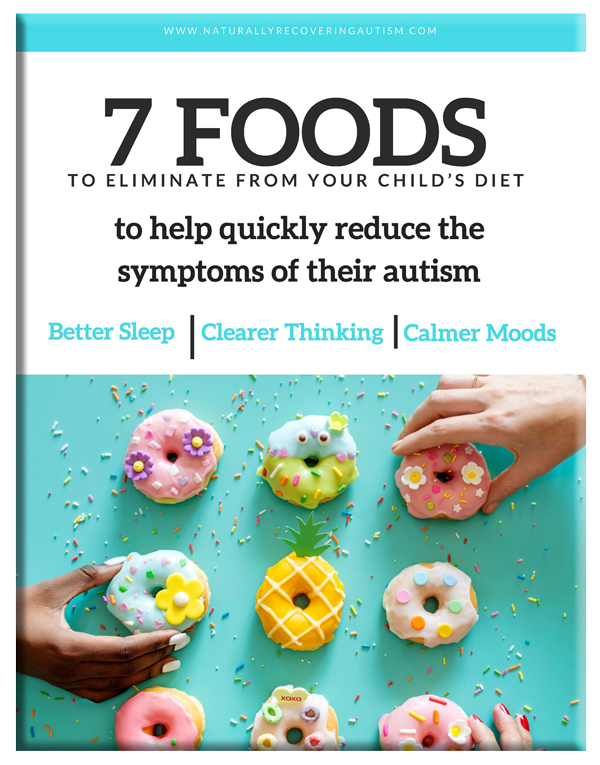Lyme disease is on the rise. One in every four children on the autism spectrum tests positive for Lyme disease. It is the fastest growing vector-borne infection with 300,000 new cases per year. This number is said to likely be an underestimate. It continues to be under-diagnosed due to the Center for Disease Control’s inadequate established bands or markers used for detection in blood tests.
Lyme disease is usually contracted through a tick bite. Some of these ticks can be as small as a poppy seed and go unnoticed. Lyme can be passed in utero from a mother to her child, as well as in breast milk. Lyme can also be passed from mosquitoes, sand fleas, head lice and other insects.
Symptoms of Lyme disease (which can also mimic other disorders including symptoms of autism):
- Attention deficit disorder (ADD)
- Learning difficulties
- Obsessive compulsive disorder (OCD)
- Depression
- Anger/rage
- Tantrums
- Increase in oppositional behavior
- Abdominal pain
- Headaches
- Night sweating
- Chills
- Possible fever or flu-like symptoms
- Frequent urination
- Sudden onset of sleep disturbance
- Joint pain
- Neck pain
- Fatigue
- Difficulty breathing
- Dry cough
- Sole of foot pain
- Visual problems
- Poor balance
- Hand flapping
- Emotional withdrawal
- Irritability
- Reduced social participation
- red/purple stretch marks (can be anywhere on the body)
- Bell’s Palsy (facial drooping)
- Alzheimer’s
- Schizophrenia
- Multiple sclerosis
- Chronic fatigue
- Fibromyalgia
- Heart conditions
Lyme disease is Borreliosis. Borrelia is the scientific name for Lyme. Borrelia is the bacteria that causes Lyme disease.
Bartonella
Bartonellosis is a bacterial disease starting with a red mark that can become swollen and discolored or even look like “stretchmarks” or striations.
Bartonella, in immunocompromised people, is known to trigger new blood vessels to grow from pre-existing ones. There’s a theory that Bartonella can trigger growth of new blood vessels into stretch marks (or even cause the stretch marks) making them red or purplish.
Bartonella can cause a linear rash, now known as Bart-tracks, that can have an appearance similar to stretch marks, sometimes red and often around the pelvic region. While this seems to be very specific for Bartonella, there is now some data based on skin biopsies to suggest that Borrelia burgdorferi (the bacteria that causes Lyme disease) can also be found in the same location as Bartonella in the skin.
Babesia
Babesia is a tiny parasite that infects your red blood cells. Babesiosis is spread by the bite of an infected blacklegged (or deer) tick. It can also be spread by transfusion of contaminated blood and possibly from an infected mother to her baby during pregnancy or delivery. Babesiosis is not spread from person to person.
The same tick that carries the Babesia parasite can also carry the corkscrew-shaped bacteria responsible for Lyme disease. A 2016 study found that up to one-fifth of people diagnosed with Lyme were also infected with Babesia.
Many people who are infected with Babesia microti feel fine and do not have any symptoms. Some people develop nonspecific flu-like symptoms such as fever, chills, sweats, headache, body aches, loss of appetite, nausea (the feeling of sickness in the stomach), or fatigue. It can also lead to a special type of anemia called hemolytic anemia (a condition where red blood cells are destroyed) lasting from several days to several months.
Antibiotic resistant
Here is a quote from Dr. Horowitz’s publication in 2016, The Use of Dapsone as a Novel “Persister” Drug in the Treatment of Chronic Lyme Disease/Post Treatment Lyme Disease Syndrome:
Johns Hopkins researchers in 2015, as well as researchers from Northeastern University (Kim Lewis and colleagues) demonstrated that Borrelia burgdorferi can form persister cells. Persisters are a small fraction of quiescent bacterial cells that survive lethal antibiotics but can regrow leading to post-treatment relapse. Examples include mycobacterium, syphilis, endocarditis, and biofilm infections.
Does antibiotic resistance play a role in Bartonella infections?
Yes, antibiotic resistance plays a significant role in Bartonella infections. In the April 2019 issue of Antibiotics, research on antibiotic resistance from Johns Hopkins was published in the article “Identification of FDA-Approved Drugs with Activity against Stationary Phase Bartonella henselae.” What they found was that a number of drugs that were not routinely used for Bartonellosis and without previous evidence for antibacterial activity, did in fact completely eradicate the stationary phase B. henselae after 3 days in culture. They also found that the drugs currently used to treat Bartonellosis such as rifampin, azithromycin, and ciprofloxacin had poor activity against the stationary phase B. henselae. This is consistent with what we are seeing in clinical practice. Many patients are being treated with conventional antibiotics and not getting better and this is causing other doctors to question the diagnosis of the infection in these patients. These patients can have a chronic infection with Bartonella and yet not respond to treatment.
This is why I work naturally with herbal formulas in my program that are specifically developed to fight these bacteria.
Testing For Lyme
As mentioned above, detecting Lyme through the standard “blot” blood test is minimal, at best. It is common to get a false negative. This means that if a blood test comes up negative you may actually be positive. So what do you do?
If you decide to test, best practice is to wait until your child’s gut is healthy, toxins have been reduced greatly, and his immune system is strong before testing, so blood markers have a better chance of showing up for Lyme. This said, it does not mean that any test will show positive when a person still is.
As a personal rule, I do not like to do tick analysis as it is not a reliable method, although it is used for supportive information sometimes. Currently the resource is www.tickchek.com, but it is best to go with symptoms. Labs should always come secondary to patient symptoms.
Prevention of Lyme via tick and other insect bites
It is important to be out in nature and get our feet onto the earth, but we must be aware of ticks, and mosquito bites, etc, contracted with Lyme and other bacteria. Anything with DEET or toxic ingredients should be avoided. OFF repellent is very toxic. Do NOT use it!!
Natural Tick and Insect Repellents
External Sprays
Two great natural mosquito and tick repellents are Repel Plant-Based Lemon Eucalyptus Insect Repellent made with essential oils, but do try it on a small patch of skin before applying it everywhere to be sure there aren’t sensitivities.
The other natural insect repellent that I use regularly is Terrashield essential oil spray from Doterra. Terrashield already has a carrier oil in it to make it less sensitive for anyone to use. You can purchase it at, NaturallyRecoveringAutism.com/oil. Either product can be sprayed on clothing or skin to repel. Long sleeves and long pants are best if they are in grasses. Keep him out of tall grasses where these bugs may be. Solid clothing is also easier to see bugs on than multicolored and patterned clothing.
Six minutes of high heat in a dryer has been shown to kill ticks on fabrics. As soon as you come inside, throw all the clothing you’ve worn outside into the dryer on the highest setting for 20 minutes, for extra assurance, (and sheets too if you’ve been camping).
An Internal Tick Repellent
Cistus Incanus (Rock Rose herbal tea) is an herb that fights biofilm which is important in its own, but it also helps naturally repel ticks. If you drink some of the tea every day, or take the tincture (a higher concentration and easier to get enough in) then it can help.
Bacteria and viruses surround themselves with a protective matrix called biofilm. Within biofilm bacteria are 100-1,000 times harder to kill. They resist antibiotics, anti-fungals, disinfectants, and anti-virals.
Cistus incanus has been shown to break down this protective biofilm, and it has been shown to repel ticks when ingested as tea or tincture.
Cistus tea: Generally sipping small amounts throughout the day.
Cistus tincture is an alternative to tea that is more concentrated and a nice option if you prefer not to make so much tea every day. It lasts a long time too. Begin with just a drop a day in the beginning and work your way up to more.
Preventing the Spread of Lyme To Our Children
Lyme Disease is transferred in utero to the unborn fetus, passed through breastmilk, and some of the bacteria can be spread in saliva. Be sure to properly work with Lyme prior to conception to avoid this transference or at least to minimize it.
If you know you have Lyme or have been bitten by a tick or an insect that may have caused you to feel sluggish or ill afterward, then know it is likely you carry it. If you have given birth since then or breastfed since then it is likely your child has contracted it from you.
Lyme mimics many symptoms of autism, and remember it does not show up in most tests and is often antibiotic resistant. Let symptoms be your best guide in moving forward.
Lyme lives in parasites
When doing any kind of parasite eradication it is important to address Lyme simultaneously because Lyme lives inside of parasites. If we kill off the parasites then the Lyme can release into the bloodstream and cause a newer systemic case of Lyme symptoms.
Need help? I can walk you through this process safely, and effectively.
Join our Free Autism Recovery Workshop, The 4 Stages to Naturally Recover from the Symptoms of Autism. Stage 1: Healing the gut, Stage 2: Natural heavy metal detoxification, Stage 3: Clearing the Co-infections, Stage 4: Brain support and repair. Reserve your online seat here.
An additional podcast with toxins and coinfections is, What Causes The Symptoms Of Autism [Podcast Episode #134]
Quickly Reduce Your Child’s Symptoms
of Autism by Eliminating 7 Specific Foods that Most People Consume Daily!
The first crucial step of autism recovery is to begin restoring health to the gut and the immune system.
The health of the gut is directly linked to the health of the brain and therefore to the symptoms of autism. In fact, 80% of the immune system comes from the gut so if the gut is not healthy, then the brain can’t thrive, and the immune system is compromised. It’s a vicious cycle, but thankfully, it’s one that we can put an end to by first eliminating harmful foods.
This is for informational purposes only and is not meant to diagnose or treat. Every child’s level of recovery is different. No two people are the same. It is never implied that all children will have the same outcome. Results are all based on individual biology and the work that is done. This process takes time and various steps, effort and resources need to be weighed. Our programs are intended to help you become more knowledgeable and guide you to help bring your child a better quality of life, whatever that may be. We want to help by giving great content, direction and strategies that move you forward. Nothing on this page or any of our websites is a promise or guarantee of results or future outcomes. The results on this page and any of our websites are not typical or promised. In fact, there will be people who purchase this and other programs and never put the work into implementing the strategies taught and therefore will achieve little to no results. Our more detailed earnings disclaimer, privacy policy, and terms and conditions for this program and website can be accessed via the links below. We hold ourselves (and you) to a high standard of integrity. We are cheering you on every step of the way.











